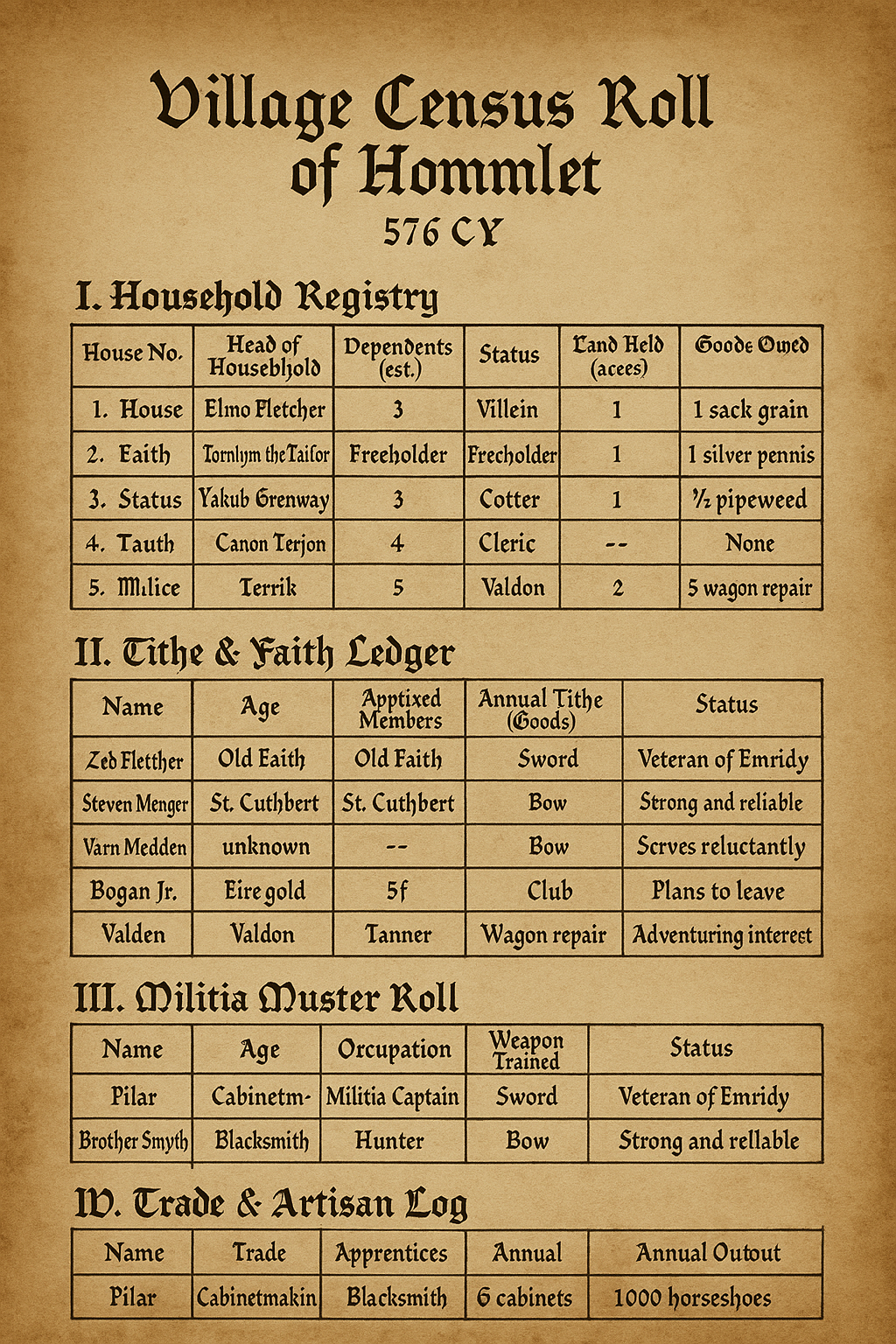Medieval Methods for Population Counting
In medieval Europe, there was no single, standardized method for counting population. Instead, population numbers were estimated or recorded in a fragmented and purpose-driven way—mainly for taxation, feudal obligations, or ecclesiastical administration.
Here’s how they did it:
Medieval Methods for Population Counting
1. Feudal Surveys and Manorial Rolls
- The most common source of population data came from landholder records.
- Manorial rolls, censuses, and extents listed:
- Names of heads of households
- Number of serfs, free tenants, and villeins
- Amount of land held
- Obligations in labor or goods
- Example: A manor might list “5 villeins, 3 cottars, 2 bordars” but not count children or women.
2. Domesday Book (England, 1086)
- Commissioned by William the Conqueror for taxation purposes.
- Did not count individuals directly, but:
- Households, plough teams, slaves, and livestock were recorded.
- Historians extrapolate total population from household numbers (e.g., multiply by average household size ~4.5–5.0).
3. Parish Records (Later Medieval Period)
- As the Church became more involved in recordkeeping:
- Baptism, marriage, and burial records helped estimate local populations.
- These become more systematic after ~1300 CE, especially in diocesan tax records.
- Tithe lists and ecclesiastical censuses served to calculate how many owed a tenth of their produce.
4. Musters and Military Levies
- Lords and kings occasionally called for feudal levies or musters:
- Lists of able-bodied men available for war.
- Sometimes included family members or retainers.
- These are useful for estimating adult male populations.
5. Poll Taxes and Hearth Taxes
- Some kingdoms (notably England and France) conducted poll taxes or hearth taxes:
- Individuals paid a flat tax (poll tax) or based on the number of hearths (fires) in their home.
- England’s 1377–1381 poll tax records are among the first with named individuals.
What Did "Population Count" Actually Mean?
| Method | What Was Counted | Accuracy | Purpose |
|---|---|---|---|
| Manorial Rolls | Heads of households | Low | Feudal dues |
| Domesday-like Surveys | Holdings and serfs | Medium | Taxation, control |
| Parish Registers | Baptisms, burials | Higher | Ecclesiastical |
| Poll Tax Returns | Individual names (adults) | High | Royal revenue |
| Military Musters | Able-bodied men | Medium | War preparation |
For D&D / Verbobonc Use:
If you're designing a village like Hommlet, a realistic medieval-style estimate might go like this:
- 1 manor holds records of 20 households.
- Each household = ~4.5 people.
- Estimated population: ~90 people, but only 20 adult males may be listed by name.
- Tithes and militia rosters will show partial data; clerics and tax collectors might dispute totals based on season and famine.
Village Census Roll of Hommlet
Year: 576 CY
Prepared by: Name of Reeve or Clerk
**For the Lord of Hommlet and the Viscount of Verbobonc_
I. Household Registry (Feudal & Economic)
| House No. | Head of Household | Dependents (est.) | Status | Land Held (acres) | Labor Owed | Goods Owed |
|---|---|---|---|---|---|---|
| 01 | Elmo Fletcher | 3 | Villein | 1 | 2 days/week | 1 sack grain |
| 02 | Tomlyn the Tailor | 4 | Freeholder | 0.5 | None | 12 linen bolts/year |
| 03 | Yakub Greenway | 2 | Cotter | 1 | 1 day/week | 1 bundle pipeweed |
| ... |
Note: Villeins owe both labor and goods; Freeholders pay only rent; Cotters have minimal land and lighter obligations.
II. Tithe & Ecclesiastical Register (Church of St. Cuthbert & Old Faith Grove)
| House No. | Faith | Baptized Members | Annual Tithe (Goods) | Notes |
|---|---|---|---|---|
| 01 | Old Faith | 4 | 1 goat, 2 sheaves | Hunts more than farms |
| 02 | St. Cuthbert | 4 | 1 silver penny | Devout, attends services |
| 03 | St. Cuthbert | 2 | 1/2 pipeweed bale | Distant demeanor |
| ... |
III. Muster Roll (Able-bodied for Militia / Levy)
| Name | Age | Occupation | Weapon Trained | Status | Notes |
|---|---|---|---|---|---|
| Zeb Fletcher | 45 | Militia Captain | Sword, bow | Mounted | Veteran of Emridy |
| Stetven Menger | 25 | Farmer | Spear, shield | Infantry | Strong and reliable |
| Bogan Jr. | 16 | Tanner's Apprentice | Bow | Youth Militia | New recruit |
| Felen Potter | 20 | Potter | Club | Reserve | Adventuring interest |
| ... |
Note: All males aged 15–60 subject to service unless clergy or infirm. Daughters may serve if self-equipped.
IV. Trade & Artisan Log
| Name | Trade | Apprentices | Annual Output | Guild/Faith |
|---|---|---|---|---|
| Valden (Wagonwright) | Wagons & Repairs | 2 | 3 wagons/year | St. Cuthbert |
| Pilar | Cabinetmaking | 1 | 6 cabinets | Old Faith |
| Smyth | Blacksmithing | None | 100 horseshoes | Druidic Craft |
| Maizy Potter | Pottery & Glazing | 4 children | 50 jars/year | St. Cuthbert |





Comments